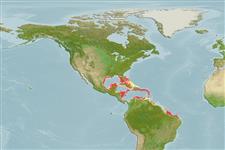>
Ovalentaria/misc (Various families in series Ovalentaria) >
Pomacentridae (Damselfishes) > Chrominae
Etymology: Chromis: Greek, chromis = a fish, perhaps a perch (Ref. 45335).
Environment: milieu / climate zone / depth range / distribution range
Ecologia
marino associati a barriera corallina; non migratori; distribuzione batimetrica 15 - 116 m (Ref. 13442), usually 15 - 30 m (Ref. 9710). Tropical; 35°N - 23°S, 100°W - 34°W
Western Atlantic: southern Florida, USA and the Caribbean Sea (Ref. 7247) to northern Brazil (Ref. 57756). More abundant at continental locations (Ref. 51183).
Size / Peso / Age
Maturity: Lm ? range ? - ? cm
Max length : 10.0 cm TL maschio/sesso non determinato; (Ref. 9710)
Short description
Chiavi di identificazione | Morfologia | Morfometria
Spine dorsali (totale) : 13; Raggi dorsali molli (totale) : 11 - 12; Spine anali: 2; Raggi anali molli: 11 - 12. Adults gray brown dorsally, often shading white ventrally, with purple- blue markings, many as vertical lines; upper edge of eye bright purple-blue; juveniles blue (Ref. 13442).
Adults occur in steep outer slopes and deeper patch reefs (Ref. 7247). Oviparous, distinct pairing during breeding (Ref. 205). Eggs are demersal and adhere to the substrate (Ref. 205). Males guard and aerate the eggs (Ref. 205).
Life cycle and mating behavior
Maturities | Riproduzione | Spawnings | Egg(s) | Fecundities | Larve
Oviparous, distinct pairing during breeding (Ref. 205). Eggs are demersal and adhere to the substrate (Ref. 205). Males guard and aerate the eggs (Ref. 205).
Allen, G.R., 1991. Damselfishes of the world. Mergus Publishers, Melle, Germany. 271 p. (Ref. 7247)
IUCN Red List Status (Ref. 130435)
Threat to humans
Harmless
Human uses
Pesca: commerciale; Acquario: Commerciale
Strumenti
Special reports
Download XML
Fonti Internet
Estimates based on models
Preferred temperature (Ref.
123201): 23.9 - 28, mean 26.8 °C (based on 126 cells).
Phylogenetic diversity index (Ref.
82804): PD
50 = 0.5000 [Uniqueness, from 0.5 = low to 2.0 = high].
Bayesian length-weight: a=0.01778 (0.00796 - 0.03971), b=2.99 (2.81 - 3.17), in cm total length, based on LWR estimates for this Genus-body shape (Ref.
93245).
Trophic level (Ref.
69278): 3.4 ±0.45 se; based on food items.
Resilienza (Ref.
120179): Alto, tempo minimo di raddoppiamento della popolazione meno di 15 mesi (Preliminary K or Fecundity.).
Fishing Vulnerability (Ref.
59153): Low vulnerability (10 of 100).
Nutrients (Ref.
124155): Calcium = 109 [52, 172] mg/100g; Iron = 0.848 [0.493, 1.437] mg/100g; Protein = 18.2 [16.9, 19.4] %; Omega3 = 0.142 [0.080, 0.246] g/100g; Selenium = 29.6 [14.8, 60.0] μg/100g; VitaminA = 147 [42, 500] μg/100g; Zinc = 1.4 [0.9, 2.0] mg/100g (wet weight);
